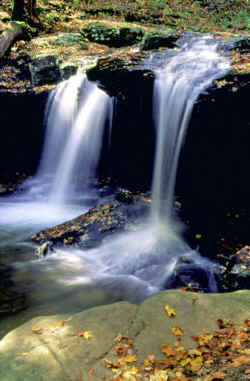 |
|||
|
|
|||
|
|
|||
|
Our Goal is Conservation
Tennessee Paddle is proud to focus on the
conservation of the Obed and Emory watersheds and the Obed Wild and Scenic River
(WSR) national park. In March 2000 there was a celebration of officials and environmentalists of the victory of having the Obed named as an ONRW. Read the proclamation here. How will Tennessee Paddle Benefit
the Obed Wild and Scenic River National Park?
Tennessee Paddle's goal is to support the Obed area in
three areas: 1. Activities and projects that will directly benefit the Obed Wild and Scenic River national park. These mostly involve allocating money for the purchase of materials and equipment such as equipment to automate water gauges to facilitate data acquisition and to install new gauges. 2. Projects that involve "warm bodies" to do physical work such as water quality sampling, trash cleanups, installing interpretive signs at trailheads and access points as well as multi-disciplinary restoration activities like the" Crag Day" climbing area cleanup and restoration held September 9, 2000. 3. Projects that will benefit people living in Morgan County and the entire Obed / Emory watershed area. These projects may include recreational and/or environmental education, activities for students, adults and local government officials. Making an online donation to Tennessee Paddle is easy using a Visa/MasterCard or checking account draft. We're a 501 (c) 3 non-profit group. Its a secure transaction. No information remains on our server and you can be assured that we will never sell, barter, or trade your personal information to anyone. If you like, you can designate your on-line contribution to one of the three areas. Your tax-deductible donation for conservation is appreciated.
About the Obed Wild and Scenic River
The Obed Wild and Scenic River (WSR)
includes 5,057 acres of land in eastern Tennessee and portions
of the Obed and Emory rivers and Clear and Daddy’s Creeks
(45.2 river miles total). The
Obed is managed by the National Park Service, Department of
the Interior. The park
was created in 1976 and is currently one of over 150 wild and
scenic rivers nationally.
The Obed WSR is one of nine such rivers in the
Southeastern U.S and
the only wild and scenic river in Tennessee. The Obed WSR flows into
the Tennessee River. The
four principal streams of the watershed, the Obed River, Clear
Creek, Daddy’s Creek and the Upper Emory River drain 615
square miles in Cumberland, Morgan, and Fentress Counties. Stream Gradients
The high gradient streams are similar to
other streams on the Cumberland Plateau on average dropping 19
feet to 34 feet per mile. Stream Flows
Between high flows during storm events and
low flows during dry seasons, there is high variability in the
flows in the Obed WSR streams.
Stream flows on the Emory River at Oakdale, Tennessee
have measured nearly nine cubic feet/second (cfs) to more than
190,000 cfs recorded in March 1929. Approximately 10 percent of
the time, flow in the Obed River at Lancing is greater
than 2500 cfs and another 10 percent of the time less than 20
cfs. What is a Wild and Scenic River?
Under the Wild and Scenic Rivers Act of 1968
(Public Law 90-542), “certain selected rivers of Nation
which, with their immediate environments possess outstanding
remarkable scenic, recreational, geologic, fish and wildlife,
historic, cultural, or other similar values, shall be
preserved in free-flowing condition, and that they and their
immediate environments shall be protected for the benefits and
enjoyment of future generations.” Impoundments
The reduction of water quantity to a river
system reduces the natural physical and biological
variability. Within the Obed River Watershed, there are numerous ponds and water
supply impoundments that may have cumulatively altered the
natural flows in the system. There
is currently no comprehensive planning or management within
this watershed. Between
the period of 1943-1946, 388 impoundments were added to the
watershed (total surface area 522 acres).
From 1976-1987, another 748 impoundments were added.
Most recently, between 1988-1994, another 1767
impoundments were constructed within the watershed.
Today, the total number of impoundments are 2903 with a
total surface area of 2903 acres.
14 of the impoundments are more than 50 acres in size
including Lake Tansi, Brown Creek Lake, Fox Creek Lake,
Dartmoore Lake, and Lake Holiday. Recent Controversy Over Damming of
Clear Creek
During the early 1990’s, the Catoosa
Utility District located in Cumberland County proposed a
100-acre lake and water treatment plan for construction on
Clear Creek. The site
was located approximately 26 miles upstream of the Obed WSR.
Several conservation
organizations, paddling groups, and other citizen
groups joined together to oppose the dam and eventually forced
Cumberland County to conduct a study to evaluate other
alternatives. Currently,
it appears there is little chance there will be a dam on the
Clear Creek. Citizens
organizing together made a big difference to this river! Highest Designation under the Clean
Water Act
In 1997, staff of the Tennessee Department
of Environment and Conservation (TDEC) recommended that the
Obed Wild and Scenic River be designated an Outstanding
National Resource Water (ONRW) under the Clean Water Act.
Such a designation means that the water quality be
preserved at current standards with no degradation.
After a great deal of controversy surrounding this
proposed designation, NPCA, TCWP, and paddlers came together
to fight for this important designation which was granted
during the summer of 1999. Water Quality
The designation of the Obed WSR as
Outstanding National Resource Water (ONRW) is important
because it will address future proposed pipes and other direct
sources of water pollution into the river.
Unfortunately, this Clean Water Act designation will
not completely address all the water quality problems to the
Obed WSR. Nonpoint
source pollution, discussed more fully below, is not regulated
under the Clean Water Act and therefore can still be a threat
to this important national river. Water quality is the most
important and sensitive ecosystem component of the Obed WSR.
The quality and quantity of the water is essential to
the biological resources and overall condition of the Obed WSR.
Currently the major impacts of pollution to this
watershed are mostly nonpoint source pollution including
organic enrichment, low dissolved oxygen, nutrients, siltation,
and flow alterations from municipal point sources, land
development, and dam construction in upstream Crossville,
Tennessee. The major
source of water pollution is from improper agricultural and/or
forestry practices with secondary
impacts from acid mine drainage. In other words, those forestry and/or agricultural practices which
do not use Best Management Practices are the most frequent
contributors to water pollution.
According to the Obed Water Resources Management Plan,
“water resources and riparian environments are principle
resources of the Obed WSR. The water is considered to be among the highest quality in the
state supporting a rich ecological diversity.
However, activities outside the Obed WSR Park System
Unit influence the waters within its boundaries.
The activities include:
coal mining, oil and gas exploration, quarrying, sewage
discharge, agricultural and forestry practices, garbage
disposal and construction of numerous water supply ponds and
impoundments on tributaries of the Obed and Emory Rivers.” Obed River:
Currently the primary impacts to the Obed River are
from upstream impacts from the City of Crossville, urban
development, water plant backwash, and the low flow effect
from Lake Holiday. Clear Creek:
Clear Creek is currently demonstrating little evidence
of impact though there are slightly elevated levels of
conductivity, fecal coliform, and fecal streptococcus from
agricultural practices and human waste disposal. If you'd like more information or have suggestions please e-mail our conservation team. We
need your support and financial help.
|
||||
|
©
1999 - 2000 Tennessee Paddle, All Rights Reserved |
|

 Current
threats to the Obed area watersheds include degrading water
quality, upstream land development and sprawl, lack of
necessary operating funds, and a significant number of
impoundments.
Current
threats to the Obed area watersheds include degrading water
quality, upstream land development and sprawl, lack of
necessary operating funds, and a significant number of
impoundments.